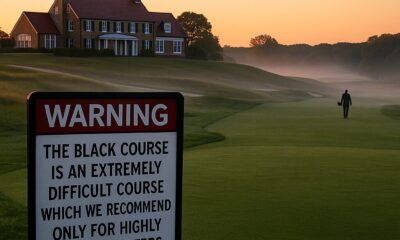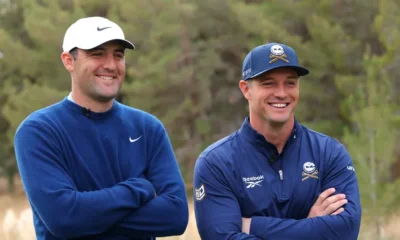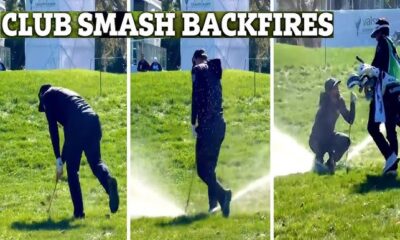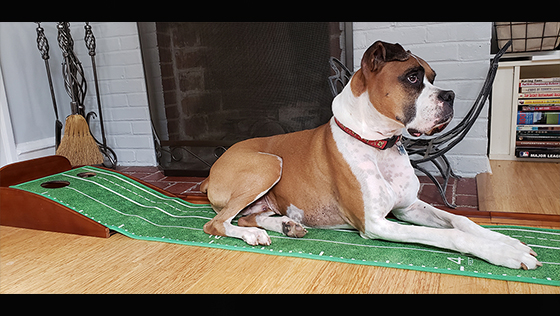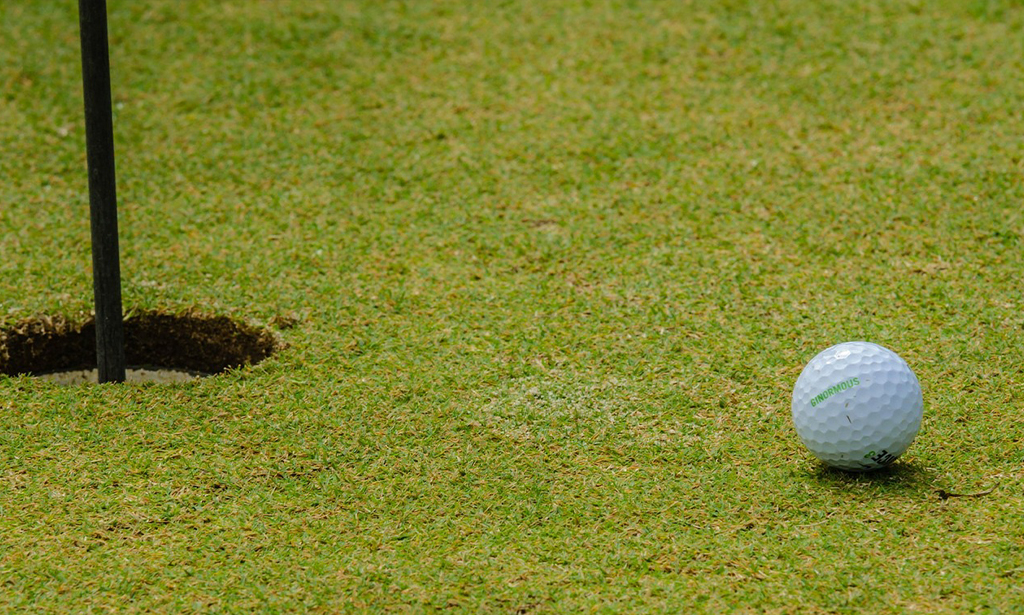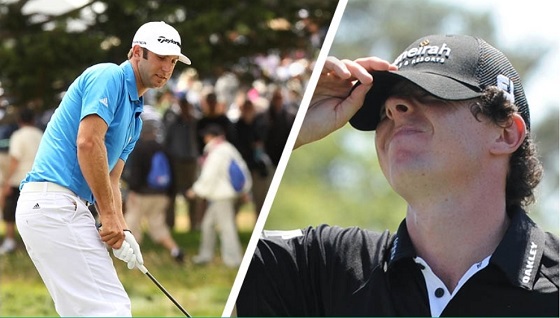News
The Unsolved Mystery Behind Augusta’s $1.50 Snack…

The Masters Champions Dinner, the golf world’s most revered dinner invitation is once again upon us. A tradition unlike any other, will once again be held at Augusta National this year… Ah Hah Moment – No wonder why I love April so much!
Here’s the low down: More than 30 green jacket winners will congregate in an opulent lounge on the second floor of golf’s most exclusive grounds, Augusta National clubhouse, on the Tuesday evening before the tournament starts for a meal that many will subsequently describe as the greatest of the year.
Scottie Scheffler, the current champion, has the honor of selecting the menu for this year’s event as is customary. Recently, Scheffler has put a lot of effort into creating a meal in the style of himself with the help of his wife Meredith and the culinary team at Augusta National. Cheeseburger sliders, firecracker shrimp, tender Texas ribeye, and charred redfish are among the menu items. There are also a number of rare treats from the club’s wine cellar, and a warm chocolate chip cookie pan completes the meal.
The reigning Masters winner is reportedly in charge of planning every aspect of the event, from the soup course to the dessert garnish. Most champions take this responsibility very seriously, painstakingly nurturing their wine selections and sourcing their ingredients from far-off places.
The one menu item that this (or any) tournament champion has chosen not to examine may be the most serious aspect of the Champions Dinner. This aperitif is a tradition unto itself; it is a snack that is so deeply ingrained in club culture and so closely associated with the Champions Dinner that it is served without hesitation at all significant club events.
This is the tale of the olives at Augusta National, including the club legend who discovered them, the custom that solidified them, and the 129-year-old family business that produced them.
They are the most cherished food in the club. They might also be the world’s best olives if you believe the palates of people who eat them every year.

How The Heck Did it All Start?
Shoot, simply put…In the beginning, Augusta National had golf, and it had olives. Boom done – well not really. So read on.
It is challenging to determine the exact beginnings of the club’s obsession with the greenish fruits that garnish its tables, but it is simpler to understand how its kitchen staff learned to appreciate them. Cliff Roberts is his full name.
Roberts was an Augusta National co-founder. The club’s initial chairman, “Mr. Roberts” (as he was known by practically everyone who knew him), was a revolutionary force in bringing the club and the competition to national prominence in the early 20th century.
By all accounts, Roberts was a control freak. He ruled the club and its competition with an iron fist, swift to correct anybody who didn’t live up to his rigorous standards. There are many tales of his meticulousness, but few are more representative of his meticulousness than the year the club’s renowned azaleas dared bloom early. It was reported that Roberts gave the order to the grounds crew that spring to pack each plant with ice to stop the bloom.
Even the founder’s appetite was affected by his habits. Every day at the Augusta National clubhouse, Roberts would place the same order—a grilled chicken breast sandwich on white toast—after studying the menu, according to David Owen in his book The Making of the Masters.
However, the dish Mr. Roberts enjoyed the best wasn’t on the menu and didn’t require one. Without his request, it was given to him at the start of each meal. The food was a real delicacy, an amuse-bouche that suited the club’s modest, old-world charm: delicately charred cornmeal and golf ball-sized olives.
Naturally, Roberts was picky about his olives. He had grown to enjoy a certain brand over time. His preferred olives were large, greenish in color, and had a delicate flavor. They had a briny, meaty combination that was both reminiscent of a conventional black olive and noticeably more subdued. Roberts requested that the olives be served straight from the tin as opposed to the club’s other dishes, which were provided to visitors exclusively in the finest glassware.

Before long, Roberts’ preference became club tradition. Many of the club’s biggest meals were served with an amuse-bouche of cornbread and olives in homage to the founder. After the first Champions Dinner was held in honor of Ben Hogan in 1952, the dish quickly became a staple.
Today, a conversation with any number of former Masters winners reveals that, among Augusta National’s many traditions, none is more beloved by those at the Champions Dinner than the pre-dinner snack.
“Oh, the olives,” said Larry Mize, the 1987 winner. “Bernhard Langer sits next to me and we love the olives. The olives are out of this world. Even if you’re not an olive fan, I’ve never had an olive like this.”
“Those olives are absolutely the most delicious thing on earth,” agreed Fuzzy Zoeller, the 1979 winner, in a 1999 Sports Illustrated interview with Alan Shipnuck. “Arnold [Palmer] and I usually have a contest to see who can put more of them away.”
Indeed, Augusta National’s olives are so famous, some former winners have grown protective of the tradition. Asked recently about the Champions Dinner’s olive obsession, the ever-playful 1992 champion Fred Couples answered coyly.
“Did Sandy put you up to that?” Couples said with a grin, referencing the 1988 winner, Sandy Lyle. “Was it Trevor [Immelman, ’08]?”
As it turned out, Couples himself was the culprit. He is the only Masters champion to include the club’s olives on his Champions Dinner menu.
“They’re about this big,” Couples said, positioning his thumb and pointer finger about an inch apart. “I sit next to Sandy and he inhales them. I don’t know where they get them, but they’re huge.”
Couples couldn’t remember — or perhaps chose not to disclose — the club’s olive source, but he did offer a clue: anyone could buy them, so long as you knew where to look.
“I’ve never bought ’em,” Couples added. “But everyone at the Champions Dinner buys them, and they ship ’em to their house.”
Rather than accept culpability for disclosing a club secret, Couples steered us toward his old pal Tom Watson (’77, ’81), who he’d heard was on the distribution list.
“Graber olives,” Watson said. “You can buy them in the can. They’re great.”
Then, not sensing the smoking gun, Watson doubled down.
“G-R-A-B-E-R.”

Come On…Can They Really Be That Good?
For me, not a chance. I would rather fight 3 foreign nationals than eat one, yet I digress…Olives are an acquired taste, even these olives.
Back in the early 1980s, Cliff Graber learned that lesson the hard way when he tried to woo a pretty girl with a box of his family’s olives. The woman, who detested green olives, was mortified by the gesture.
“He said, ‘Open a can, try them!’” she remembers. “I stared at them for a while, and finally said, ‘Oh, my family will love them when they come to visit.’”
Cliff would eventually convince the girl, Maura, to try her first Graber olives. Perhaps as a testament to the product, or to his persistence, she gave him a shot. The two have been married for 32 years, forming the third generation of the Graber Olive Co.
“I’m just not a green olive eater,” Maura says today of the initial rejection.
Cliff, it seems, is still getting over it.
“They weren’t green.”
Maura — the family’s matriarch — wasn’t the first family member to hold an aversion to olives, nor would she be the last.
“I’ve tried other olives, but to be honest with you, I don’t like them,” Maura’s son, Robert, the youngest Graber says. “I don’t like the taste at all.”
But Robert, like the three generations of Grabers before him, still adores the family crop.
“If you blindfolded someone and they tasted one of our olives, they wouldn’t even think it was an olive,” Robert says. “It’s a very mild, salty taste. It sort of melts in your mouth.”
For what it’s worth, the hype isn’t purely situational — Graber olives are different from their grocery store counterparts. As opposed to other olives, which are picked from the tree in one fell swoop, Graber olives are “full tree-ripened,” meaning they are removed from the branch only when they’ve reached peak ripeness. This results in larger, more robust fruit, which, combined with the family’s secret saltwater brining process, produces Graber’s distinctive taste. As a result, Graber olives are neither black nor green, but a color wholly their own.
“When we pick them, they’re a purplish, reddish color,” Maura said. “Then they turn greenish brown during the processing. They’re the only olives that can really be called tree-ripened.”
The Graber Olive Company was founded by C.C. Graber in 1894 on the remains of a fruit farm, but it wasn’t until the 1930s that the Grabers realized their good fortune. The Graber olive house was in Ontario, Calif. — directly en route to Hollywood’s two glitziest vacation destinations. “We were partway to Vegas, and halfway to Palm Springs,” Maura said.
Before long, Graber had become the olive to the stars, counting L.A. giants like Bing Crosby, Paul Newman and Bob Hope as devotees. A cult following grew, and soon the Grabers were an institution, shipping cans all over the world. Today, there are four generations of Grabers who have worked in the olive business — C.C., Robert, Cliff and Robert II — which is in its 129th year in 2023.
The family business is a tradition all its own for the Grabers, and that heritage surely endears itself to the family’s one and only bulk client: a golf club — also on the remains of a fruit farm — 150 miles east of Atlanta. It isn’t like the Grabers to offer their cans wholesale, but this club isn’t your average customer.
Around the Graber business, the client goes by only one name… – AUGUSTA!
Here’s My Theory – For the Record I am Conspiratorial
The Graber family has been selling olives to Augusta National for so long, they’re not even sure when the relationship started.
“We’d always been told that Arnold Palmer was the first,” Maura said. “It was 1959, and Arnold Palmer supposedly walked into his green jacket dinner and asked, ‘Where are the Graber olives?’”
There’s little question that Arnie, a winner in 1958, ’60, ’62 and ’64, loved Augusta National’s olives, but it seems unlikely that he was the first person to introduce the fruit to Augusta National. Several accountings of the club’s history trace its olive roots back to Clifford Roberts in the 1930s, decades before Palmer’s arrival. The Graber family concedes it’s possible the Palmer story is just “folklore.” At the very least, it’s evidence that Graber olives were served at the club before Palmer’s Champions Dinner arrival.
“So much of our records are lost or in paper somewhere,” Maura said. “I’m sure we have the answer, but I just don’t know where.”
(The club, following a long-standing tradition of discretion surrounding its business matters, did not respond to GOLF’s request for comment on the origins of its olives.)

There is no such ambiguity around the club’s current ordering structure. Augusta National has purchased olives from Graber the same way since at least the 1950s. A member of the club staff will call Cliff Graber, strictly by phone, to place an order. Historically, the club interacts only with Cliff, and purchases only one product: size-16 olives. And why size 16?
“It’s the biggest one we sell,” Robert said.
According to the Grabers, a size-16 olive measures an average of 1 inch in diameter — a biblical size for the inside of a martini glass. For reference, a golf ball is 1.68 inches in diameter.
Graber sells only a finite number of size-16 cans each season, and inventory is growing more limited due to the effects of climate change. Still, the Graber family ensures an Augusta National-sized order of size-16 cans is set aside at the beginning of each harvest. (Size-16s are sold out on the Graber website, with none expected back in stock soon.)
“All we know is that we’re the only olives they serve,” Maura said.
Some years, as with this year, the club will place multiple orders in a season. But, on average, the Grabers said, Augusta National spends more than $5,000 annually with them. The club’s most recent order was for 528 cans of size-16s — at a cost of a little more than $5,500.
Cost is irrelevant to most Graber olive customers, because few olive-lovers who have tried Grabers find themselves capable of returning to life before them. Witness the scene at the Masters Champions Dinner.
“We love them,” Larry Mize said. “If they don’t bring them around, [Bernhard] Langer and I will request them, and they’ll go get them for us.”
“The olives are famous,” concurs Langer, a champion in 1985 and ’93.
Close to a century after this great tradition began, there is a certain amount of pride the Grabers feel in their relationship with Augusta National — and a certain amount of shock at the response their olives have received.
“I was having work done on my teeth about 10 years ago, and the dentist told me he did an internship where he got to go to the Masters,” Maura recalled. “And he says, ‘I can’t believe it. I sat down at a table at Augusta National and there was a bowl of Graber olives!’”
Sometimes, the Grabers can’t believe it either. After all these years — 129 of them — they’ve become a Masters tradition.
“People just love them,” Maura said. “It’s hard not to get excited about something your customers are so excited about.”
From a distance, it’s easy to see the Graber olive story as one of cosmic destiny; a mingling of fate and divine intervention. But destiny doesn’t explain the one piece of the story the Grabers still can’t answer: How did Clifford Roberts find them?
“Cliff Roberts,” I asked the Grabers recently. “Does that name mean anything to you?”
On the other end of the line, they began to laugh, the noise crackling through the phone.
As the laughter quieted, the elder Graber shuffled toward the phone.
“Well, yes,” he said. “The name does mean something to us.”
“My grandpa was Cliff, and my dad was Robert, and I’m Cliff, and my son is Robert.”
We may never know how Clifford Roberts discovered his beloved Graber olives, but we may not need to. As it turns out, some Masters mysteries are even better unsolved. I hope this one stays locked in the vault!

Check back often to stay informed on everything happening on and off the course.
- Why you need to stop aiming left on greenside bunker shots
- Rolex Women’s World Golf Ranking releases new points updates ahead of 2026 season
- The 1 part of Tiger Woods’ legacy we’re waiting to understand
- 3 gear trends I am happy to leave behind in 2025
- Why this putting mirror was my favorite purchase of 2025
- The year’s best-selling accessory is a striking conversation-starter
- What ‘loft jacking’ gets wrong about modern irons
- Our 6 favorite golf resorts we visited in 2025
- 1 easy way to instantly make more putts | 5 key tips for 2026
- 5 great drills to improve your distance control when putting
- I Tried It: Why this walker’s dream bag was the best thing I used in 2025
- Bethpage’s ugly Ryder Cup was a feature, not a bug
- Tiger Woods’ most painful Masters memory? It means something different now
- How do you hit a long bunker shot? Short-game expert breaks it down
- Why this common advice is actually terrible for your swing
News
The 6 Most Ridiculous Rules in Golf

Let’s get these changed ASAP huh Fellas?
Remember Dustin Johnson pleading to a rules official during the final round of the 2016 U.S. Open. I had his back and most of the world did too.
They say you can’t fix stupid, but you are able to complain about it and hopefully get it changed. Golf, this game we love, there is plenty of senselessness to go around. Witness the Rules of Golf, an encyclopedic catalog of do’s and don’ts that often fall beyond the bounds of reality
For argument’s sake, here’s our take on six of the dumbest rules in the most beloved sport on the planet. OK, maybe I am biased, but the game is pretty old and may need a little botox here and there. Just Sayin’

1. The Dreaded “DJ Rule
In the official ledger, it’s Rule 18-2. But ever since the 2016 U.S. Open, it’s more widely recognized as that *&%$!!!-ing Dustin Johnson Rule. You know, that nonsensical one under which the eventual tournament winner was slapped with a one-shot penalty for supposedly causing his ball to move a nano-millimeter on the 5th green. Never mind that he clearly didn’t intend to set the ball in motion, or that the micro-movement gave him no discernible advantage. The punishment stood. But we shouldn’t have to stand for it in the future. How about this? Next time around, no harm, no foul. Move the ball back, end of story!

2. No Relief from Sand-Filled Divots – In the fairway?
Let’s see if we understand correctly: if we spray a tee shot off-line and our ball winds up in the ground under repair zone, we’re entitled to relief. But if we smoke one down the middle and it settles in a sand-filled crater left behind by another golfer, we’re doomed to play it as it lies. That ground we landed in happened to be damaged. Someone tried to repair it. Sounds to us like… the ground is under repair. Now Im no genius, but are you following me here?
2. The “DROP”
You’d think that hitting a shot into a hazard would be punishment enough. But you’d be wrong. Under the Rules of Golf, the dogged victim then has to go through the tedious ritual known as the drop, which brings other potential rules infractions into play. If the dropped ball moves closer to the hole (as it so often does) twice, the player gets to place it. So why not just allow placement from the start? It would spare the player undue pain, and save the rest of us a lot of time.
3. Stroke & Distance
In American jurisprudence, it’s known as double jeopardy, a procedural defense that protects us from being prosecuted twice for the same crime. Sounds reasonable, right? No such safeguard exists for a golfer who bangs a ball into oblivion, only to be slapped with a stroke penalty on top of loss of distance. That’s two punishments for one misdeed, and it’s unjust by any measure. We, the people, call for a one-stroke penalty and lateral relief. Motion Carries!
4. Sprinkler Head in Your Putting Line
Your approach shot lands pin high, just on the collar, and a straightforward putt awaits, with just one problem: a sprinkler head lies in your putting line. Common sense suggests that you should get relief, no closer to the hole; a sprinkler head, after all, is a man-made impediment. But common sense apparently has no place here. Your only hope is that the course you’re playing has a local rule that allows line-of-play relief from immovable obstructions within two club lengths of the green, which, let’s be reasonable here, should really be the rule that governs all play.
5. Five Minutes for a Lost Ball – Really?
That lax allowance dates back to a bygone era, when life moved at a pastoral pace and golfers had the luxury of lollygagging. This is the modern age. Chop, chop, time’s a-wasting. We’ve got cat videos to watch and vapid tweets to send. The game needs to adapt. And besides, if you can’t find that errant ball in two minutes, you probably don’t want to in the first place. It will be under a rock or in a bush but with just enough clearance that those 9 deadly words are uttered “I think I can get a club on it”
6. Cant move a ball from a footprint in a bunker – This one Grinds my Gears
It might make sense on Tour, where players all have caddies and the grounds are as well-groomed as the gardens of Versailles. But many of the courses we mortals play are under-tended and trod upon by etiquette-flouting chops who don’t even attempt to rake up their mess, creating hazards within hazards. The more sensible alternative: if your ball lands in a footprint in a bunker, move it and place it elsewhere in the sand. Done, End of rant. You may go about your business.
Blog
When Golf Meets Supercars: The World Series of Golf Takes Over Skip Barber’s Mexico Resort
World Series of Golf partners with Skip Barber Racing for a two-year luxury sports series at Gran Reserva, Mexico – where championship golf meets supercars starting April 2026.

Picture this. You’re standing on the 18th green at Gran Reserva, Mexico, finishing a round of championship golf with the World Series of Golf’s signature betting format still buzzing in your veins. The sun’s dropping low. Your heart’s still racing from that final putt.
And tomorrow? You’re driving a McLaren on Skip Barber’s brand-new racetrack.
Two Sports, One Unforgettable Weekend
The World Series of Golf just announced something we’ve never seen before. A two-year partnership with Skip Barber Racing School that transforms their new Mexican resort into the ultimate luxury sports destination. It’s not just golf. It’s not just racing. It’s both, wrapped into an experience that redefines what a sporting weekend can be.
Starting in April 2026, Gran Reserva becomes ground zero for a completely new kind of event.
Year One: The Foundation
The first year lays the groundwork. You’ll compete in the World Series of Golf championship using their patented tournament format – the one that adds poker-style betting mechanics to traditional stroke play and turns every hole into a strategic showdown. High stakes. Real tension. Golf the way it was meant to be played.
But here’s where it gets interesting. While you’re playing, Skip Barber’s building their racetrack right there on the property. You’ll see construction crews working on what will become one of North America’s most anticipated racing circuits. State-of-the-art simulators give you a taste of what’s coming, letting you experience the thrill of motorsports between rounds.
VIP receptions. Celebrity appearances. Curated culinary showcases that match the caliber of the competition. It’s an invitation-only event designed for people who expect excellence and aren’t willing to settle for anything less.
Year Two: The Payoff
Then 2027 hits. The track is finished. And suddenly you’re not just imagining what it’s like to drive a supercar at speed – you’re actually doing it.
McLaren. Ferrari. Mercedes. Lamborghini. Take your pick and put it through its paces on a circuit designed by people who’ve spent over 50 years teaching professional racers how to extract every ounce of performance from a machine. Skip Barber doesn’t mess around when it comes to motorsports education, and this track reflects that pedigree.
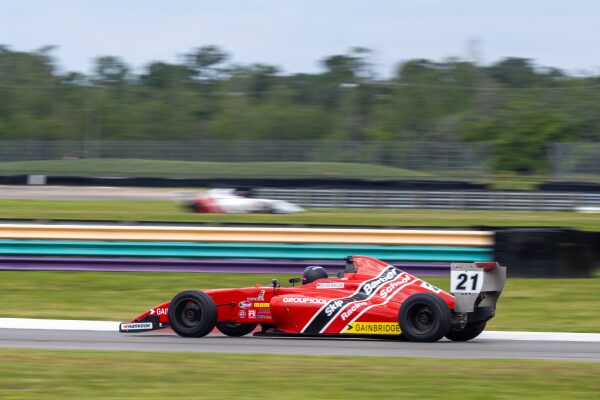
You’ll stay in exclusive luxury accommodations at Gran Reserva, network with athletes and industry leaders, and experience both golf and racing at the highest possible level. All in one place. All in one unforgettable weekend.
Why This Matters
Michael Berg, CFO of Skip Barber Racing School, called it perfectly: “Guests will see the racetrack under construction during our first event and then drive world-class vehicles on it the following year.”
That’s the hook. You’re not just attending an event. You’re watching it evolve. You’re part of the story from day one, and by year two, you’re living the payoff.
Robert Davidman, CEO of the World Series of Golf, added this: “This partnership unites golf and motorsports in an elevated format that caters to international fans seeking competition, luxury, and adventure.”
Competition. Luxury. Adventure. Three words that sum up what makes this special.
Why Sponsors Are Paying Attention
Here’s what makes this different from every other golf tournament trying to get your marketing dollars.
The World Series of Golf’s patent-protected format keeps spectators glued to every shot. Shot-by-shot wagering. Antes that double every three holes. Strategic decisions that matter as much as swing mechanics. It’s golf designed for television, and television designed to keep people watching.
Add Skip Barber Racing to the mix and you’ve got something networks actually want to cover. Over 40 hours of TV coverage. More than 15 million media impressions. Five million-plus social media reach. This isn’t a local tournament hoping for some local news pickup. This is a broadcast-ready event with an audience that’s already paying attention.
The demographics tell the rest of the story. You’re reaching affluent golf enthusiasts who also appreciate high-performance automobiles. International travelers who think nothing of flying to Mexico for a weekend of luxury sports. Decision-makers and industry leaders who network at VIP receptions and actually have the authority to sign deals on the spot.
Title sponsorship gets you naming rights, eight playing positions, and premium TV exposure throughout the broadcast. But even smaller packages deliver value. Hole sponsors get exclusive on-course branding and social media mentions for ten grand. Golf cart wraps guarantee TV and photo exposure because every shot of the tournament includes your brand.
The opportunities are limited by design. Only 18 hole sponsors. Three presenting sponsors. One title sponsor. Once they’re gone, they’re gone.
Want the details? Check out the full sponsorship packages at wsg.golf/sponsorship.
The Bottom Line
This isn’t your typical golf tournament. It’s not your standard track day either. It’s something entirely new – a two-year luxury sports series that gives you the best of both worlds and raises the bar for what a sporting experience can deliver.
Year one plants the seed. Year two delivers the harvest. And whether you’re attending as a player or partnering as a sponsor, you’ll be there for both.
For player inquiries, contact events@skipbarber.com. For sponsorship opportunities, reach out to sponsorship@wsg.golf. These events are strictly invitation-only, and opportunities won’t last long.
Golf and supercars. Mexico and motorsports. The World Series of Golf and Skip Barber Racing School.
This is going to be something special.
-

 Product Review6 years ago
Product Review6 years agoThe Perfect Practice Putting Mat Review by Jason Tenzer
-

 Blog4 years ago
Blog4 years agoLoophole Rule Offers PGA Tour Pros a Mulligan
-

 Blog4 years ago
Blog4 years ago2021 Buyer’s Guide: The Top 10 Value Golf Balls For Distance & Feel
-

 Blog5 years ago
Blog5 years agoGolf Marriage Counselor
-

 Blog6 years ago
Blog6 years ago9 Biggest Chokes Of The Past Decade
-

 Product Review6 years ago
Product Review6 years agoTHE ADJUSTABLE IRONS: WALKING STICKS GOLF CLUBS
-

 Blog4 years ago
Blog4 years agoWhat Your Golf Clubs Say About You
-

 Equipment6 years ago
Equipment6 years agoOHK Sports Interview by Jason Tenzer




